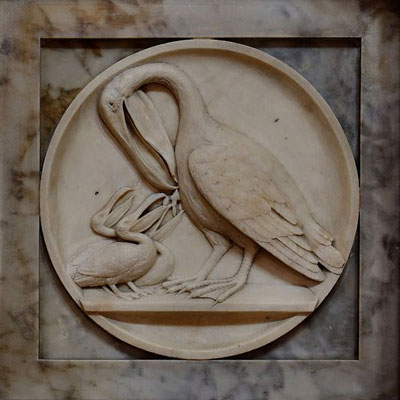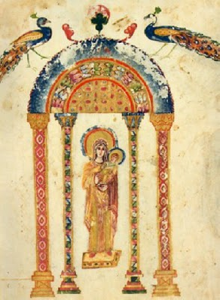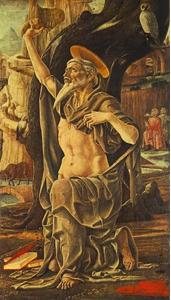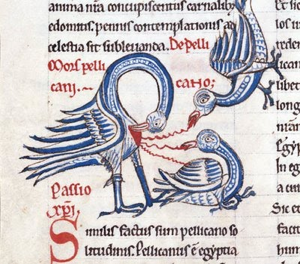Sacred number in art: St Matthew’s tells us there are 14 generations from Abraham to David, 14 from David until the Babylonian exile and 14 from the Babylonian exile to Christ. Matthew wrote in Aramaic. In this language, the characters of the alphabet are also used for numbers. This allows for every name to characterized both in letters and numbers. When the letters that comprise the name David are treated as numbers and added together it creates the number 14. This numerical symbolism emphasizes the fact that Christ in a king in the line of David, as prophesied.
Can Man Read the Symbolic Book of Nature Today?
 Or Should We Just Rely on Our Gothic Forebears? I recently wrote about the quincunx and its relationship to the traditional image of Christ in Majesty showing with symbolic representation of the four evangelists, here. Frenchman Emile Male described how the understanding of how these four figures related to the evangelists in the 13th century (his book is called, The Gothic Image). Male is drawing on a commentary on Ezekiel by Rabanus Maurus, the 9thcentury Benedictine monk and bishop of Mainz in Germany, which, he says became the authoritative text for the later gothic period. Reading this is helpful in understanding the roots of this symbolism, but rather like an earlier discussion of the pelican and the peacock, not without a few difficulties also.
Male recounts it as follows:
Or Should We Just Rely on Our Gothic Forebears? I recently wrote about the quincunx and its relationship to the traditional image of Christ in Majesty showing with symbolic representation of the four evangelists, here. Frenchman Emile Male described how the understanding of how these four figures related to the evangelists in the 13th century (his book is called, The Gothic Image). Male is drawing on a commentary on Ezekiel by Rabanus Maurus, the 9thcentury Benedictine monk and bishop of Mainz in Germany, which, he says became the authoritative text for the later gothic period. Reading this is helpful in understanding the roots of this symbolism, but rather like an earlier discussion of the pelican and the peacock, not without a few difficulties also.
Male recounts it as follows:
‘The emblem of St Matthew is the man, because his gospel begins with the genealogical table of the ancestors of Jesus according to the flesh. The lion designates St Mark, for in the opening verses of his gospel he speaks of the voice crying in the wilderness. The ox – the sacrificial animal – symbolizes St Luke whose gospel opens with the sacrifice offered by Zacharias. The eagle, who alone among birds was reputed to look straight into the sun, is a symbol of St John who from the very first transports men to the very heart of divinity.
‘Again these same creatures are symbols of Christ for in them may be seen four great mysteries of the life of the Saviour. The man recalls the Incarnation. The ox, victim of the old Law calls to remembrance the Passion. The lion which in fabled science sleeps with its eyes open is the symbol of the Resurrection for, [quoting Maurus] “in virtue of his humanity He appears to sink into the sleep of death, by virtue of His divinity He was living and watching”. The eagle is the figure of the Ascension because for Christ rose as the eagle soars to the clouds.
‘There is a third meaning relating to human virtue: each Christian on his way to perfection must be at once man, ox, lion and eagle. He must be man because man is a reasonable animal; he must be ox because ox is the sacrificial victim; he must be lion because the lion is the most courageous of animals and the good man having renounced worldly things has nothing to fear for it is written of him “the righteous are as bold as the lion”. And he must be eagle because the eagle flies into the heights looking straight into the sun, type of the Christian who with direct gaze contemplates the things of eternity.’

There is some confusion here on my part, in that I had always thought that the first symbol was an angel, and not a man. Reading Ezekiel again, he describes the appearance of the first figure as 'human with wings' rather than as an angel. The ox and the lion are described as having wings as well, and these are still described in the tradition as ox and lion, so I have taken it that the first figure is human, or at least as human as any ox with wings is bovine. Scripture scholars please help!
Male then remarks upon the fact that two thirds of the triple-layered symbolism fell away as early as the Renaissance, as man became less inclined to interpret nature symbolically. Is this something to be regretted, I wonder?
 My personal opinion is that the symbolic reading of the book of nature is important. I feel it highlights for us that God's dealings with his creatures have two aspects, one external and one internal: the natural and the supernatural; with the first pointing the second. Newman put it: 'Of necessity, Providence is secretly concurring and co-operating with that system which meets the eye.' (Nature and Supernature) The book of nature that can be read in the light of faith and understood as something that both emanates from and points to the Word. (A priest recently put it to me beautifully thus: ‘The Mass is a jewel in its setting, which is the liturgy of the hours; and the two together are a cluster of precious stones that themselves have a setting which is the cosmos.’)
My personal opinion is that the symbolic reading of the book of nature is important. I feel it highlights for us that God's dealings with his creatures have two aspects, one external and one internal: the natural and the supernatural; with the first pointing the second. Newman put it: 'Of necessity, Providence is secretly concurring and co-operating with that system which meets the eye.' (Nature and Supernature) The book of nature that can be read in the light of faith and understood as something that both emanates from and points to the Word. (A priest recently put it to me beautifully thus: ‘The Mass is a jewel in its setting, which is the liturgy of the hours; and the two together are a cluster of precious stones that themselves have a setting which is the cosmos.’)
The symbolism of which we speak in this particular example is firmly rooted in the tradition, and is biblically based and so we can happily use it. But if we accept the value of the richer, gothic interpretation – should we aim to restore it uncritically? Certainly, much of it we can adopt quite happily – and many of the observations of nature would be considered true today, or at least acceptable even if not literally true (even in today’s rationialist society people accept some ideas that might be difficult to establish scientifically (eg the courage of the lion).
However, what if some of the interpretation is based upon what was believed at the time to be scientific fact, and which is no longer held to be true or even accepted as myth? I am thinking here of the idea that the eagle looks directly into the sun, or that lions sleep with their eyes open. (My understanding is that neither is considered true today).
I would say that to include such aspects of the gothic symbolism in our picture would reduce the possibilities of it being broadly accepted, and so undermine the greater point we are trying to make. However, we don't need to abandon the idea altogether. We should not be afraid to develop and adapt them based upon things that we do know to be true. If gothic man could read the book of nature, why can’t we learn to do it too? In fact once we accept the principle, modern science might even enrich our symbolic reading of nature. Who would have thought, for example, see here,that in particle physics, the 'flavours' of the sub-atomic 'hadronic particles' would follow the pattern of the Pythagorean tetractys, which symbolises musical harmony and was described in Boethius's De Musica? To take another example, the four ‘elements’ of Aristotle – air, earth, fire, and water – do not correspond to the physical elements of modern physics and chemistry, but do symbolise very well what would be described today as the physical states of matter – solid, liquid, gas and energy (or perhaps plasma). The idea being communicated is the same.
Similarly, if indeed the eagle does not look directly into the sun, the symbolism of the eagle can easily be adapted into something that we do accept to be true today and is emphasizing the same point – it has extraordinary eyesight that operates in dim and bright light and could be seen as a symbol of one who is focused on the Light with an unerring and penetrating gaze.
Images: top, 9th century German ivory; second from top, tiles manufactured by the Pugin company in England in the 19th century; third from top, Christ in Majesty, illustration by David Clayton for Meet the Angels; and below the four evangelists by Rubens.
Pelican Brief – Should We Aim to Revive All Christian Symbols?
 Is there a danger that trying to reestablish traditional Christian symbols in art would sow confusion rather that clarity? Lots of talks and articles about traditional Christian art I see discuss the symbolism of the iconographic content; for example, the meaning of the acacia bush (the immortality of the soul) or the peacock (again, immortality). This is useful if we have a printed (or perhaps for a few of you an original) Old Master in church or a prayer corner as it will enhance our prayer life when contemplating the image. But is this something that we ought to be aiming to reinstate the same symbolism in what we produce today? Should we seek to educate artists to include this symbolic language in their art?
If symbols are meant to communicate and clarify, they should be readily understood by those who see them. This might have been the case when they were introduced – very likely they reflected aspects of the culture at the time – and afterwards when the tradition was still living and so knowledge of this was handed on. But for most it isn’t true now. How many would recognize the characteristics of an acacia bush, never mind what it symbolizes? If you ask someone today who has not been educated in traditional Christian symbolism in art what the peacock means, my guess is that they are more likely to suggest pride, referring to the expression, ‘as proud as peacock’. So the use of the peacock would not clarify, in fact it would do worse than mystify, it might actually mislead. (The reason for the use of the peacock as a symbol of immortality, as I understand it, is the ancient belief that its flesh was incorruptible). So to reestablish this sign language would be a huge task. We would not only have to educate the artists, but also educate everyone for whom the art was intended to read the symbolism. If this is the case, why bother at all, it doesn’t seem to helping very much, and in the end it will always exclude those who are not part of the cognoscenti . This is exactly the opposite of what is desired: for the greater number, it would not draw them into contemplation of the Truth, but push them out.
Is there a danger that trying to reestablish traditional Christian symbols in art would sow confusion rather that clarity? Lots of talks and articles about traditional Christian art I see discuss the symbolism of the iconographic content; for example, the meaning of the acacia bush (the immortality of the soul) or the peacock (again, immortality). This is useful if we have a printed (or perhaps for a few of you an original) Old Master in church or a prayer corner as it will enhance our prayer life when contemplating the image. But is this something that we ought to be aiming to reinstate the same symbolism in what we produce today? Should we seek to educate artists to include this symbolic language in their art?
If symbols are meant to communicate and clarify, they should be readily understood by those who see them. This might have been the case when they were introduced – very likely they reflected aspects of the culture at the time – and afterwards when the tradition was still living and so knowledge of this was handed on. But for most it isn’t true now. How many would recognize the characteristics of an acacia bush, never mind what it symbolizes? If you ask someone today who has not been educated in traditional Christian symbolism in art what the peacock means, my guess is that they are more likely to suggest pride, referring to the expression, ‘as proud as peacock’. So the use of the peacock would not clarify, in fact it would do worse than mystify, it might actually mislead. (The reason for the use of the peacock as a symbol of immortality, as I understand it, is the ancient belief that its flesh was incorruptible). So to reestablish this sign language would be a huge task. We would not only have to educate the artists, but also educate everyone for whom the art was intended to read the symbolism. If this is the case, why bother at all, it doesn’t seem to helping very much, and in the end it will always exclude those who are not part of the cognoscenti . This is exactly the opposite of what is desired: for the greater number, it would not draw them into contemplation of the Truth, but push them out.
I think that the answer is that some symbols are worth persevering with, and some should be abandoned. First, it is part of our nature to ‘read’ invisible truths through what is visible. This does not only apply to painting. The whole of Creation is made by God as an outward ‘sign’ that points to something beyond itself to Him, the Creator. Blessed John Henry Newman put it in his sermon Nature and Supernature as follows: "The visible world is the instrument, yet the veil, of the world invisible – the veil, yet still partially the symbol and index; so that all that exists or happens visibly, conceals and yet suggests, and above all subserves, a system of persons, facts, and events beyond itself.” It is important to both to make use of this faculty that exists in us for just this purpose; and to develop it, increasing our instincts for reading the book of nature and in turn, our faith.
However, coming back to the context of art again, some discernment should be used, I suggest. I would not be in favour of creating an arbitrarily self-consistent symbolism. The symbol must be rooted in truth. The symbolism in the iconographic tradition is very good at following this principle. This is best illustrated by considering the example of the halo. This is very well known as the symbol of sanctity in sacred art. There are very good reasons for this. The golden disc is a stylized representation of a glow of uncreated, divine light, shining out of the person. Even if this were not already a widely known symbol, it would be worth educating people about the meaning of it, because in doing so something more is revealed. When however, the representation of a halo develops into a disc floating above the head of the saint, as in Cosme Tura’s St Jerome, or even a hoop, as in Annibale Caracci’s Dead Christ Mourned, (both shown) then it seems to me that the symbol has become detached from its root. Neither could be seen as a representation of uncreated light. These latter two forms, therefore, should be discouraged.
Similarly, those symbols that are rooted in the gospels or in the actual lives of the saints should be encouraged and the effort should be made, I think, to preserve or, if necessary, reestablish them. The tongs and coal of the prophet Isaias relate to the biblical accounts of his life. The inclusion of these, will generate a healthy curiosity in those who don’t know it, and so might direct them to investigate scripture. The picture shown below, incidentally, is one that I did as a demonstration piece for our recent summer school at Thomas More College in New Hampshire.
In contrast consider the peacock and the pelican. The peacock, as already mentioned, does not, we now know, have incorruptible flesh. The pelican is a symbol of the Eucharist based upon the erroneous belief in former times that pelicans feed their young with their own flesh. The immediate reaction is that these should not be used (I am not aware of any biblical reference to these two creatures that would justify it). However, I am torn by the fact that both of these are beautiful and striking images, even if based in myth.
Also, it might be argued, and this is particularly true for the pelican, that to use it is not resurrecting an obscure medieval symbol. It is an ancient symbol certainly - and St Thomas Aquinas's hymn to the Eucharist, Adore te devote called Christ the 'pelican of mercy'. But it lasted well beyond that. It was very widely understood even 50 years ago. Awareness of it is still common nowadays amongst those who are interested in liturgy and sacred art. Perhaps an argument could be made that even when the reason for the use of symbol is based in myth, if that is known and understood, and when that symbol recognition is still widespread enough to be considered part of the tradition, it should be retained. We should also remember that modern science is not infallible, and we moderns could be those who are mistaken about the pelican! My Googling research (admittedly even less reliable than modern science) revealed that the coat of arms of Cardinal George Pell has the image of the pelican. If this is so, I imagine he would have something to say about the issue also!











